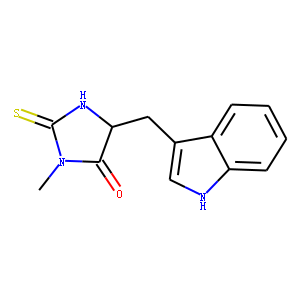| Reference | 1. Cell Death Differ. 2013 Feb;20(2):185-7. doi: 10.1038/cdd.2012.151. Epub 2012 Nov
30.
<br>
Necrostatin-1 blocks both RIPK1 and IDO: consequences for the study of cell death
in experimental disease models.
<br>
Vandenabeele P, Grootjans S, Callewaert N, Takahashi N.
<br>
2. J Cereb Blood Flow Metab. 2008 Sep;28(9):1564-73. doi: 10.1038/jcbfm.2008.44.
Epub 2008 May 21.
<br>
Necrostatin-1 reduces histopathology and improves functional outcome after
controlled cortical impact in mice.
<br>
You Z(1), Savitz SI, Yang J, Degterev A, Yuan J, Cuny GD, Moskowitz MA, Whalen
MJ.
<br>
Author information: <br>
(1)Neuroscience Center, Massachusetts General Hospital, Harvard Medical School,
Charlestown, Massachusetts 02129, USA.
<br>
Necroptosis is a newly identified type of programmed necrosis initiated by the
activation of tumor necrosis factor alpha (TNFalpha)/Fas. Necrostatin-1 is a
specific inhibitor of necroptosis that reduces ischemic tissue damage in
experimental stroke models. We previously reported decreased tissue damage and
improved functional outcome after controlled cortical impact (CCI) in mice
deficient in TNFalpha and Fas. Hence, we hypothesized that necrostatin-1 would
reduce histopathology and improve functional outcome after CCI in mice. Compared
with vehicle-/inactive analog-treated controls, mice administered necrostatin-1
before CCI had decreased propidium iodide-positive cells in the injured cortex
and dentate gyrus (6 h), decreased brain tissue damage (days 14, 35), improved
motor (days 1 to 7), and Morris water maze performance (days 8 to 14) after CCI.
Improved spatial memory was observed even when drug was administered 15 mins
after CCI. Necrostatin-1 treatment did not reduce caspase-3-positive cells in the
dentate gyrus or cortex, consistent with a known caspase-independent mechanism of
necrostatin-1. However, necrostatin-1 reduced brain neutrophil influx and
microglial activation at 48 h, suggesting a novel anti-inflammatory effect in
traumatic brain injury (TBI). The data suggest that necroptosis plays a
significant role in the pathogenesis of cell death and functional outcome after
TBI and that necrostatin-1 may have therapeutic potential for patients with TBI.
<br>
3. J Neurochem. 2007 Dec;103(5):2004-14. Epub 2007 Aug 30.
<br>
Necrostatin-1 protects against glutamate-induced glutathione depletion and
caspase-independent cell death in HT-22 cells.
<br>
Xu X(1), Chua CC, Kong J, Kostrzewa RM, Kumaraguru U, Hamdy RC, Chua BH.
<br>
Author information: <br>
(1)Department of Pharmacology, and Cecile Cox Quillen Laboratory of Geriatric
Research, James H. Quillen College of Medicine, East Tennessee State University,
James H. Quillen Veterans Affairs Medical Center, Johnson City, Tennessee, USA.
<br>
Glutamate, a major excitatory neurotransmitter in the CNS, plays a critical role
in neurological disorders such as stroke and Parkinson/’s disease. Recent studies
have suggested that glutamate excess can result in a form of cell death called
glutamate-induced oxytosis. In this study, we explore the protective effects of
necrostatin-1 (Nec-1), an inhibitor of necroptosis, on glutamate-induced
oxytosis. We show that Nec-1 inhibits glutamate-induced oxytosis in HT-22 cells
through a mechanism that involves an increase in cellular glutathione (GSH)
levels as well as a reduction in reactive oxygen species production. However,
Nec-1 had no protective effect on free radical-induced cell death caused by
hydrogen peroxide or menadione, which suggests that Nec-1 has no antioxidant
effects. Interestingly, the protective effect of Nec-1 was still observed when
cellular GSH was depleted by buthionine sulfoximine, a specific and irreversible
inhibitor of glutamylcysteine synthetase. Our study further demonstrates that
Nec-1 significantly blocks the nuclear translocation of apoptosis-inducing factor
(a marker of caspase-independent programmed cell death) and inhibits the
integration of Bcl-2/adenovirus E1B 19 kDa-interacting protein 3 (a pro-death
member of the Bcl-2 family) into the mitochondrial membrane. Taken together,
these results demonstrate for the first time that Nec-1 prevents
glutamate-induced oxytosis in HT-22 cells through GSH related as well as
apoptosis-inducing factor and Bcl-2/adenovirus E1B 19 kDa-interacting protein
3-related pathways.
<br>
|

